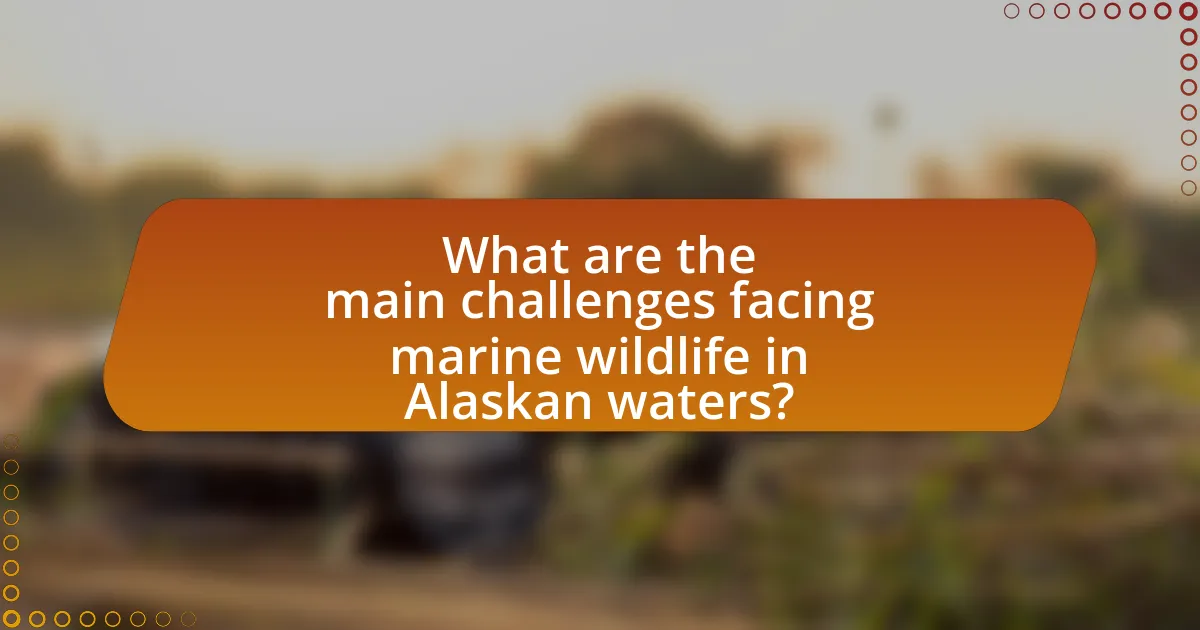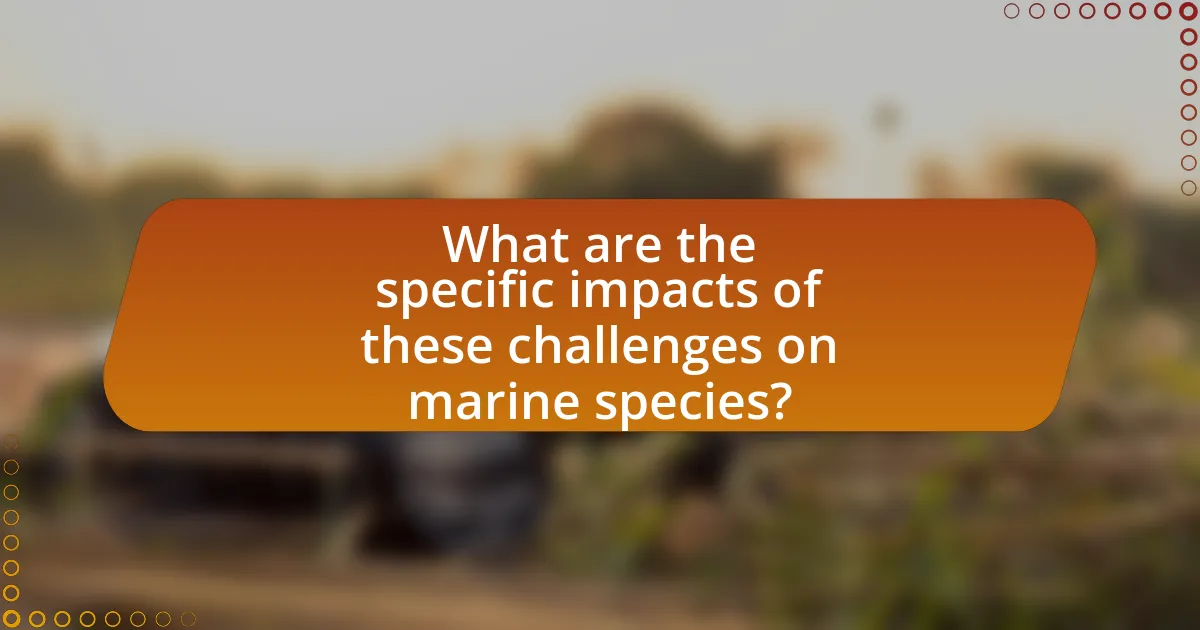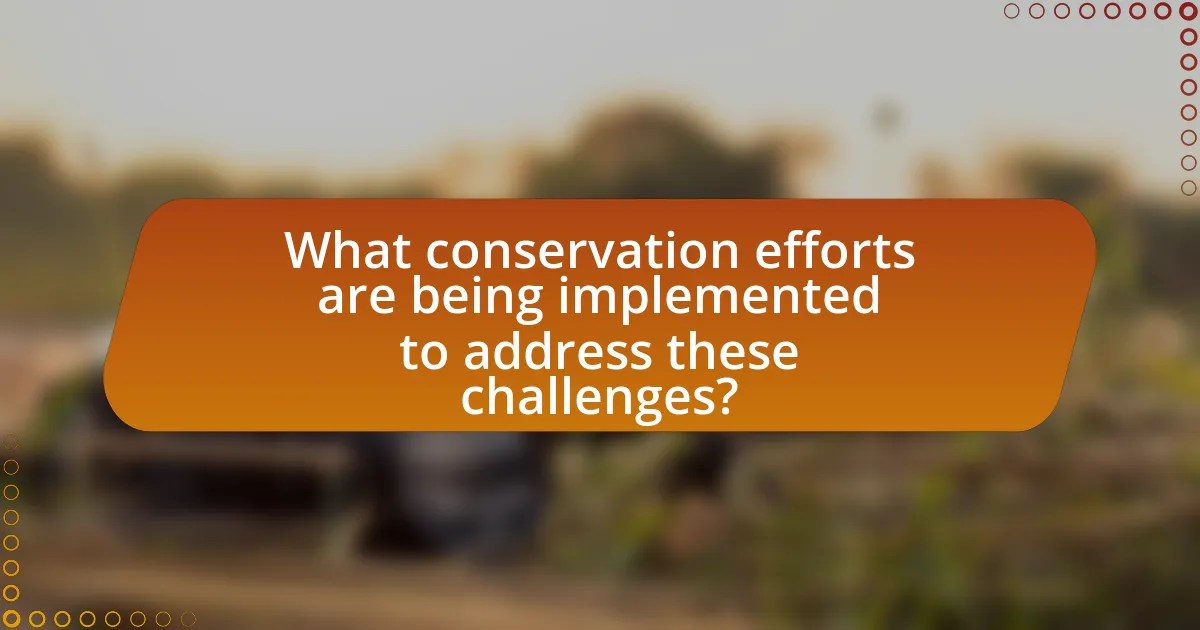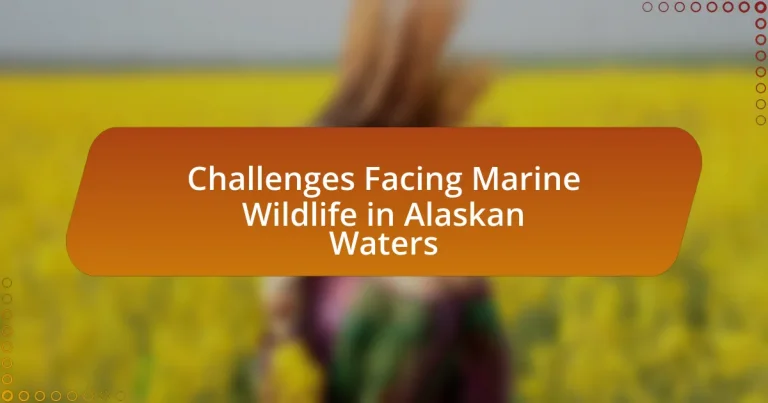The article addresses the significant challenges facing marine wildlife in Alaskan waters, primarily focusing on climate change, overfishing, and pollution. It details how climate change alters ecosystems, affecting species such as salmon and polar bears, while overfishing depletes fish stocks and disrupts food chains, threatening marine mammals. Pollution, including plastics and oil spills, further harms marine habitats and wildlife health. The article also explores the specific impacts of these challenges on fish populations, marine mammals, and seabirds, and highlights ongoing conservation efforts and the role of local communities and government policies in protecting marine biodiversity.

What are the main challenges facing marine wildlife in Alaskan waters?
The main challenges facing marine wildlife in Alaskan waters include climate change, overfishing, and pollution. Climate change leads to rising ocean temperatures and altered ecosystems, affecting species such as salmon and polar bears. Overfishing depletes fish stocks, disrupting the food chain and threatening the survival of marine mammals. Pollution, including plastic waste and oil spills, harms marine habitats and wildlife health, as evidenced by the decline in seabird populations and the contamination of marine food sources.
How do climate change effects impact marine ecosystems in Alaska?
Climate change effects significantly impact marine ecosystems in Alaska by altering water temperatures, ice cover, and nutrient availability. Warmer ocean temperatures lead to shifts in species distribution, with some species migrating northward while others face habitat loss. The reduction of sea ice affects species that rely on it for breeding and feeding, such as seals and polar bears. Additionally, changes in nutrient cycling can disrupt food webs, impacting fish populations and the species that depend on them, including seabirds and marine mammals. These changes have been documented in studies showing declining fish stocks and altered predator-prey dynamics in Alaskan waters.
What specific changes in temperature and ice cover are observed?
Specific changes in temperature and ice cover in Alaskan waters include a significant increase in average temperatures and a reduction in sea ice extent. Average temperatures in Alaska have risen by approximately 3°F (1.6°C) over the past 60 years, with projections indicating further increases. Concurrently, the Arctic sea ice extent has decreased by about 40% since the late 1970s, with the summer minimum ice extent reaching record lows in recent years. These changes impact marine ecosystems, affecting species that rely on ice cover for habitat and hunting.
How do these changes affect species migration patterns?
Changes in environmental conditions, such as rising sea temperatures and altered ice cover, significantly affect species migration patterns in Alaskan waters. These changes disrupt traditional migratory routes, forcing marine species like salmon and whales to adapt to new pathways or face population declines. For instance, studies have shown that warmer waters can lead to earlier spawning times for salmon, which may not align with the availability of food sources, ultimately impacting their survival and reproduction rates. Additionally, the shifting distribution of prey species due to changing ocean conditions can lead to mismatches in predator-prey dynamics, further complicating migration patterns for marine wildlife.
What role does pollution play in the decline of marine wildlife?
Pollution significantly contributes to the decline of marine wildlife by contaminating habitats and disrupting ecosystems. Specifically, pollutants such as plastics, heavy metals, and chemicals enter marine environments, leading to toxic effects on marine organisms. For instance, a study published in the journal “Marine Pollution Bulletin” found that microplastics are ingested by various marine species, causing physical harm and potential mortality. Additionally, chemical pollutants can accumulate in the food chain, resulting in bioaccumulation and biomagnification, which adversely affect larger predators, including marine mammals. This evidence underscores the critical impact of pollution on the health and survival of marine wildlife in Alaskan waters.
What types of pollutants are most prevalent in Alaskan waters?
The most prevalent pollutants in Alaskan waters include heavy metals, petroleum hydrocarbons, and plastics. Heavy metals such as mercury and lead often originate from industrial activities and can accumulate in marine organisms, posing health risks to wildlife and humans. Petroleum hydrocarbons primarily result from oil spills and runoff, significantly impacting marine ecosystems. Plastics, including microplastics, are increasingly found in Alaskan waters due to global ocean currents and local waste management issues, threatening marine life through ingestion and entanglement. These pollutants collectively contribute to the challenges facing marine wildlife in the region.
How do these pollutants affect marine species health and reproduction?
Pollutants significantly impair marine species’ health and reproduction by causing physiological stress, disrupting endocrine functions, and leading to developmental abnormalities. For instance, heavy metals like mercury and lead accumulate in marine organisms, resulting in toxic effects that can compromise immune systems and reproductive capabilities. Research indicates that exposure to polychlorinated biphenyls (PCBs) can lead to reduced fertility and increased mortality rates in species such as seals and whales. Additionally, studies have shown that contaminants can alter hormone levels, affecting growth and reproductive success in fish populations. These adverse effects underscore the critical impact of pollutants on the overall health and reproductive viability of marine species in Alaskan waters.
How does overfishing contribute to the challenges faced by marine wildlife?
Overfishing significantly contributes to the challenges faced by marine wildlife by depleting fish populations and disrupting the marine ecosystem. When fish are removed at a rate faster than they can reproduce, it leads to population declines, which can destabilize food webs and affect predator species that rely on these fish for sustenance. For instance, studies indicate that overfishing has led to a 90% decline in certain fish stocks in Alaskan waters, directly impacting species such as sea lions and seabirds that depend on these fish for food. This disruption not only threatens the survival of these species but also alters the overall health of marine ecosystems, making recovery increasingly difficult.
Which species are most affected by overfishing in Alaska?
The species most affected by overfishing in Alaska include Pacific cod, halibut, and various salmon species. Pacific cod populations have seen significant declines due to high fishing pressure, with assessments indicating that overfishing has led to reduced stock levels. Halibut, once abundant, has also faced overfishing, resulting in stricter catch limits to allow for population recovery. Salmon species, particularly Chinook and sockeye, have been impacted by both commercial and subsistence fishing, leading to concerns about their sustainability. These facts highlight the critical challenges that overfishing poses to marine wildlife in Alaskan waters.
What are the long-term consequences of overfishing on marine biodiversity?
Overfishing leads to significant long-term consequences for marine biodiversity, including the depletion of fish populations, disruption of food webs, and loss of species diversity. The removal of key species, such as top predators, can result in trophic cascades that alter ecosystem dynamics, ultimately diminishing the resilience of marine habitats. For instance, studies indicate that overfishing has contributed to a 90% decline in certain fish stocks globally, which directly impacts the species that rely on them for food. Additionally, the reduction in biodiversity can make ecosystems more vulnerable to environmental changes, such as climate change, further exacerbating the decline of marine life.

What are the specific impacts of these challenges on marine species?
The specific impacts of challenges facing marine species in Alaskan waters include habitat degradation, altered food webs, and increased mortality rates. Habitat degradation, primarily due to climate change and pollution, leads to the loss of critical breeding and feeding grounds for species such as salmon and seals. Altered food webs occur as rising temperatures affect the distribution and abundance of plankton, which are essential for the survival of various marine species, including fish and whales. Increased mortality rates are observed in vulnerable populations, such as polar bears and sea otters, due to factors like reduced ice cover and increased competition for food resources. These impacts are supported by studies indicating that climate change has led to a 50% decline in some fish populations in the Bering Sea over the past few decades, highlighting the urgent need for conservation efforts.
How are fish populations in Alaskan waters being affected?
Fish populations in Alaskan waters are being affected by climate change, overfishing, and habitat degradation. Climate change leads to rising ocean temperatures and altered salinity levels, which disrupt fish spawning and migration patterns. Overfishing has resulted in decreased stocks of key species such as Pacific cod and halibut, impacting the overall ecosystem balance. Habitat degradation, caused by pollution and industrial activities, further threatens fish habitats, reducing their ability to thrive. These factors collectively contribute to declining fish populations, as evidenced by studies indicating significant drops in biomass for several commercially important species in the region.
What trends are observed in key fish species populations?
Key fish species populations in Alaskan waters are experiencing significant declines due to overfishing, climate change, and habitat degradation. For instance, the Pacific cod population has decreased by over 50% in recent years, primarily attributed to rising ocean temperatures and changing prey availability. Additionally, salmon populations, particularly Chinook and sockeye, have shown fluctuating trends, with some stocks declining due to altered river ecosystems and increased competition from invasive species. These trends highlight the urgent need for sustainable management practices to address the challenges facing marine wildlife in this region.
How does the decline in fish populations affect the food web?
The decline in fish populations disrupts the food web by reducing the availability of a critical food source for various marine species. Fish serve as a primary food source for larger predators, including seabirds, marine mammals, and other fish species. When fish populations decrease, these predators face food shortages, leading to declines in their populations as well. For example, studies have shown that a significant reduction in fish stocks can lead to decreased reproductive success in seabirds that rely on fish for feeding their young. Additionally, the loss of fish can cause shifts in the ecosystem, as species that compete for the same resources may proliferate, further destabilizing the food web.
What is the impact on marine mammals in Alaskan waters?
The impact on marine mammals in Alaskan waters includes habitat loss, climate change effects, and increased shipping traffic. Habitat loss occurs due to oil and gas exploration, which disrupts feeding and breeding grounds for species such as seals and whales. Climate change leads to altered sea ice patterns, affecting the availability of prey and migration routes for marine mammals. Additionally, increased shipping traffic raises the risk of ship strikes and noise pollution, which can interfere with communication and navigation for species like the bowhead whale. These factors collectively threaten the survival and health of marine mammal populations in the region.
How are seals and sea lions responding to environmental changes?
Seals and sea lions are adapting to environmental changes primarily through shifts in their foraging behavior and habitat use. As ocean temperatures rise and ice habitats diminish, these marine mammals are altering their hunting grounds to follow prey species that are also moving in response to changing conditions. For instance, studies have shown that harbor seals in Alaska are increasingly utilizing coastal areas rather than traditional ice habitats, which impacts their breeding and pupping success. Additionally, sea lions are experiencing changes in their migration patterns, with some populations moving further north to find suitable feeding grounds. These behavioral adaptations are critical for their survival as they navigate the challenges posed by climate change and its effects on marine ecosystems.
What threats do whales face in relation to human activities?
Whales face significant threats from human activities, primarily including ship strikes, entanglement in fishing gear, and habitat degradation. Ship strikes can result in severe injuries or fatalities, with studies indicating that large vessels are responsible for a notable percentage of whale deaths, particularly in busy shipping lanes. Entanglement in fishing gear poses a critical risk, as whales can become trapped, leading to injury or drowning; research has shown that entanglement is a leading cause of mortality for certain whale species. Additionally, habitat degradation from pollution, climate change, and noise pollution disrupts feeding and breeding grounds, further endangering whale populations. These threats collectively contribute to the decline of whale species in Alaskan waters, highlighting the urgent need for conservation efforts.
How do these challenges affect seabird populations?
Challenges such as climate change, habitat loss, and pollution significantly impact seabird populations. These factors lead to decreased food availability, altered breeding habitats, and increased mortality rates. For instance, rising ocean temperatures disrupt the distribution of fish species that seabirds rely on for food, resulting in lower reproductive success. Additionally, habitat degradation from human activities reduces nesting sites, further threatening seabird survival. Studies indicate that seabird populations in Alaska have declined by over 70% in some areas due to these cumulative challenges, highlighting the urgent need for conservation efforts.
What specific threats do seabirds encounter in Alaskan waters?
Seabirds in Alaskan waters face specific threats including climate change, oil spills, and overfishing. Climate change alters their habitat and food availability, impacting breeding and survival rates. Oil spills, such as the Exxon Valdez disaster in 1989, have long-lasting effects on seabird populations by contaminating their food sources and habitats. Overfishing reduces the availability of prey species, further threatening seabird survival. These factors collectively contribute to the decline of seabird populations in the region.
How does the decline in fish populations impact seabird feeding habits?
The decline in fish populations significantly disrupts seabird feeding habits by reducing the availability of their primary food source. Seabirds, such as puffins and murres, rely heavily on fish for sustenance; when fish populations decrease, these birds struggle to find adequate nutrition. Research indicates that in regions where fish stocks have plummeted, seabird breeding success rates have also declined, as evidenced by studies showing a direct correlation between fish abundance and seabird reproductive outcomes. For instance, a study published in the journal “Ecology” highlights that seabird colonies in Alaska experienced a 50% decline in chick survival rates during years of low fish availability, underscoring the critical link between fish populations and seabird feeding habits.

What conservation efforts are being implemented to address these challenges?
Conservation efforts addressing challenges facing marine wildlife in Alaskan waters include the establishment of marine protected areas (MPAs), implementation of sustainable fishing practices, and habitat restoration initiatives. MPAs, such as the Aleutian Islands and the Gulf of Alaska, help safeguard critical habitats and biodiversity by restricting harmful activities. Sustainable fishing practices are promoted through regulations that limit catch sizes and protect vulnerable species, ensuring the long-term viability of fish populations. Additionally, habitat restoration projects, like those focused on coastal wetlands and estuaries, aim to rehabilitate ecosystems that support marine life. These efforts are supported by scientific research and collaboration among government agencies, non-profit organizations, and local communities, demonstrating a commitment to preserving marine biodiversity in the region.
How are local communities involved in marine wildlife conservation?
Local communities are actively involved in marine wildlife conservation through initiatives such as sustainable fishing practices, habitat restoration projects, and educational programs. These communities often collaborate with governmental and non-governmental organizations to implement conservation strategies that protect marine ecosystems. For instance, in Alaska, local fishermen participate in catch-share programs that promote sustainable harvesting, ensuring fish populations remain healthy. Additionally, community-led beach clean-ups and monitoring of marine species contribute to the preservation of local habitats. Research indicates that community engagement in conservation efforts leads to more effective management of marine resources, as local knowledge and stewardship enhance the success of these initiatives.
What initiatives are being taken by indigenous groups in Alaska?
Indigenous groups in Alaska are actively engaging in initiatives focused on marine conservation and sustainable resource management. These initiatives include the establishment of co-management agreements with federal and state agencies to protect marine wildlife, such as the Bowhead whale and Pacific salmon, which are vital to their subsistence lifestyle. Additionally, organizations like the Alaska Native Tribal Health Consortium are promoting traditional ecological knowledge to inform conservation practices, ensuring that indigenous perspectives are integrated into marine management strategies. These efforts are supported by data indicating that traditional practices can enhance biodiversity and ecosystem resilience in Alaskan waters.
How can community engagement enhance conservation efforts?
Community engagement enhances conservation efforts by fostering local stewardship and increasing awareness of environmental issues. When communities actively participate in conservation initiatives, they are more likely to develop a sense of ownership and responsibility towards their local ecosystems. For instance, studies have shown that community-led conservation projects in Alaska, such as the Sitka Sound Science Center’s initiatives, have led to improved management of marine resources and increased public support for sustainable practices. Engaging local populations not only provides valuable traditional ecological knowledge but also encourages collaborative efforts that can lead to more effective conservation strategies, ultimately benefiting marine wildlife in Alaskan waters.
What role do government policies play in protecting marine wildlife?
Government policies play a crucial role in protecting marine wildlife by establishing regulations and frameworks that limit harmful activities, promote conservation efforts, and ensure sustainable use of marine resources. For instance, the Marine Mammal Protection Act and the Endangered Species Act in the United States provide legal protections for various marine species, prohibiting harassment, hunting, and habitat destruction. These policies are supported by scientific research, such as studies showing that protected areas can significantly enhance biodiversity and ecosystem health, thereby reinforcing the importance of government intervention in safeguarding marine wildlife.
What regulations are in place to manage fishing practices?
Regulations to manage fishing practices include federal laws such as the Magnuson-Stevens Fishery Conservation and Management Act, which establishes guidelines for sustainable fishing and the management of fish stocks in U.S. waters. Additionally, the National Oceanic and Atmospheric Administration (NOAA) enforces regulations that set catch limits, seasons, and gear restrictions to protect marine ecosystems. These regulations are supported by scientific assessments to ensure the sustainability of fish populations, with the goal of preventing overfishing and preserving marine biodiversity in Alaskan waters.
How effective are marine protected areas in conserving biodiversity?
Marine protected areas (MPAs) are highly effective in conserving biodiversity, as they provide critical habitats and reduce human impacts on marine ecosystems. Research indicates that MPAs can lead to increased species richness and abundance, with studies showing that fish populations can double within protected zones compared to unprotected areas. For instance, a meta-analysis published in “Nature” by Edgar et al. (2014) found that MPAs have a positive effect on biodiversity, with an average increase in fish biomass of 446% in fully protected areas. This evidence supports the assertion that MPAs play a vital role in safeguarding marine biodiversity, particularly in regions facing significant environmental challenges, such as Alaskan waters.
What can individuals do to support marine wildlife conservation?
Individuals can support marine wildlife conservation by reducing plastic use, participating in beach cleanups, and advocating for sustainable fishing practices. Reducing plastic use helps decrease ocean pollution, which is a significant threat to marine life; studies show that over 8 million tons of plastic enter the oceans annually, harming wildlife. Beach cleanups directly remove debris that can entangle or be ingested by marine animals, contributing to healthier ecosystems. Advocating for sustainable fishing practices ensures that fish populations remain stable and ecosystems are not disrupted, as overfishing has led to significant declines in various species.
How can responsible tourism contribute to marine conservation efforts?
Responsible tourism can significantly contribute to marine conservation efforts by promoting sustainable practices that protect marine ecosystems. This type of tourism encourages visitors to engage in activities that minimize environmental impact, such as participating in guided eco-tours that educate them about marine wildlife and habitats. For instance, studies have shown that eco-tourism can lead to increased funding for conservation projects, as tourists often pay fees that support local conservation initiatives. Additionally, responsible tourism fosters awareness and appreciation for marine environments, which can lead to greater public support for conservation policies. According to the World Wildlife Fund, responsible tourism can help reduce overfishing and habitat destruction by advocating for sustainable fishing practices and marine protected areas.
What are some practical steps individuals can take to reduce pollution?
Individuals can reduce pollution by adopting sustainable practices such as minimizing single-use plastics, using public transportation, and conserving energy. For instance, reducing single-use plastics can significantly decrease marine debris, which poses a threat to wildlife; studies show that over 8 million tons of plastic enter oceans annually, harming marine ecosystems. Utilizing public transportation or carpooling reduces greenhouse gas emissions, contributing to cleaner air and water. Additionally, conserving energy by using energy-efficient appliances and reducing electricity consumption lowers the demand for fossil fuels, which are major pollutants. These actions collectively contribute to a healthier environment for marine wildlife in Alaskan waters.


